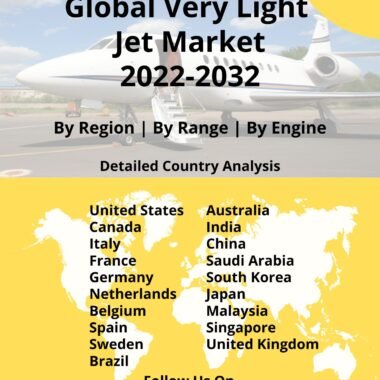Description
Very Light Jet Market
Frequently Asked Questions of Very Light Jet Market
A very light jet market is a class of entry-level jet aircraft that can be flown by a single pilot. It is also known as a personal jet or an entry-level jet market report. These aircraft once referred to as micro jets, have a maximum takeoff weight of fewer than 10,000 pounds. These planes are designed and constructed so that single pilot owners can fly them, and they are frequently lighter than private jet charters, which are also known as business jets.
Only one or two passengers are frequently transported on business charter aircraft at a time. Only the top executives, who can board a plane with seven empty seats, frequently fly privately. Because of this claim, airplane manufacturers recognized a chance to create and promote a product that targets a certain market. Very light jets were created as a result to lessen the expense and hassle of private jet travel. Customers often use private planes in the very light jet market size sector for business and to save time. As a result, for these kinds of brief flights, the aircraft with the lowest charter rates are chosen.
While the price of a typical light aircraft ranges from USD 4 million to USD 8 million, the price of a very light jet can range from USD 1 million to USD 3.6 million. The price of a very light plane has decreased because of innovative manufacturing techniques using lightweight composite materials, cutting-edge digital avionics, and smaller yet incredibly efficient jet engines that provide about 1,700 pounds of thrust and weigh only 100 to 200 pounds. A thousand-mile range, a top speed of 340 to 420 knots, and seating for four to seven passengers are all characteristics of very light jets.
Major factors driving Very Light Jet Market Growth
Very light jets market growth can pass through smaller airports and have been demonstrated to save operating costs. They, therefore, compete on price, timing, and location with larger-scale transportation aircraft. Smaller charter and air taxi companies can now buy a jet plane thanks to the low cost of the new very light jets. There are currently a dozen or so very light planes being produced, each with a different set of competitive features and all trying to satisfy consumer demand. The majority of very light jets are designed to be used as a taxi or private jets. Taxi Jets’ goal is to sell a flight ticket for the same price as a conventional business class ticket on a jumbo jet but with the added benefit of private jet service. Most jets are now shared among owners, lowering costs, lowering hanger fees, and maximizing flight time.
Trends Influencing the Very Light Jet Market Size
Very light jets market analysis are not new when compared to small propeller planes used in the private or taxi sector. There is already a facility where taxi planes fly and operate, but because of the low weight mixed with the jet engine, the flying duration is greatly shortened, with speeds up to twice as fast in some instances.
Very Light Jet Market Forecast & Dynamics
Early in the new millennium, the small aircraft transportation system (SATS) and air taxi industries saw a major increase in interest, which contributed to the growth of the very light jet industry. Among the contemporary concepts were the Embraer Phenom 100, the Cessna Citation Mustang, and the Eclipse 500. The very light jet market forecast for very light jets has a prominent demand in the Middle East. Large cabin, ultra-long-range aircraft are more prevalent in the region, particularly in the Middle East. However, because of the region’s growth over the past 25 years, there is now increased activity and demand for light, mid, and super-midsized aircraft. According to Embraer, the Praetor 600 in particular has demonstrated that it is a good fit for the Dubai–London route.
Very Light Jet Market Analysis for Recent Developments
A small number of jet card suppliers offer guaranteed availability and set one-way fares for specific aircraft types they sell in the very light jet category, which means there are no ferry fees. For instance, Nicholas Air offers the option to select any aircraft from its fleet, which includes the Embraer Phenom 100 and 300 as well as the Citation CJ3 on the Very Light Jet side. While Executive AirShare, Flexjet, JetSuite, Magellan Jets, NetJets, ProspAir, Silverhawk Aviation, TeeBee Jets, and Wheels Up each have programs centered around particular types of very light jets, OneFlight International, a broker program, offers a variety of very light jet alternatives.
HondaJet Echelon was unveiled as the official name of Honda Aircraft’s new light jet at the 2023 National Business Aviation Convention and Exhibition (NBAA-BACE). The name represents the company’s forward-thinking approach to the next-generation business jet, elevating efficiency to new heights while also providing comfort and convenience. The plane will be the world’s first single-pilot light jet capable of nonstop transcontinental flight across the United States. This offering aims to reduce operating costs while also providing an owner experience that was previously unattainable. Furthermore, the HondaJet Echelon’s design incorporates electrification and automation of its systems, resulting in enhanced pilot capabilities, reduced workload, and increased safety. The HondaJet Echelon’s design concept revolves around increasing travel efficiency in all aspects in order to fulfill missions and provide an experience typically reserved for larger aircraft. Through aerodynamic innovations, the aircraft is expected to outperform conventional light jets on typical missions by up to 20% and mid-sized jets by more than 40%. The HondaJet Echelon, previously introduced as the HondaJet 2600 Concept in 2021, establishes a new paradigm in the light jet category by providing a mid-sized jet experience. The HondaJet Echelon, as a premium addition to the HondaJet family, will also have a holistic focus on the cabin experience, including space, comfort, and productivity.
Key Companies







